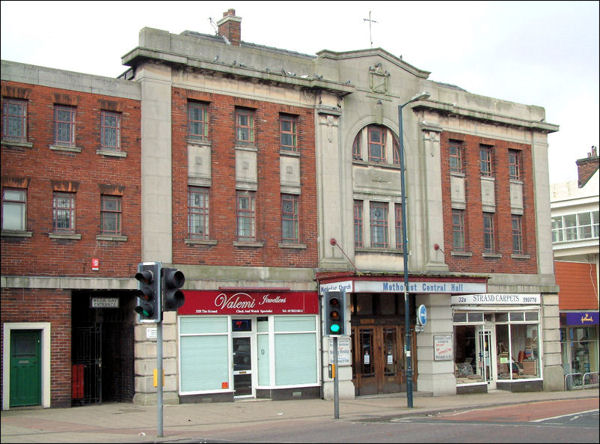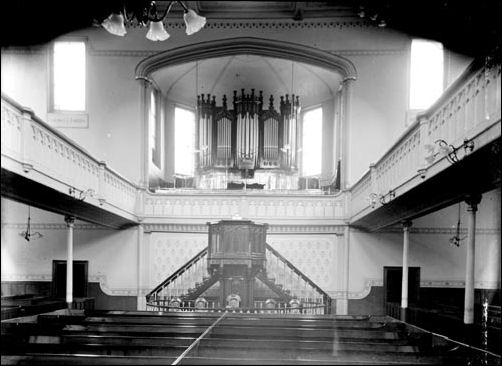|
Wesleyan
Methodist Chapels in Longton
LONGTON, CHAPEL STREET and STAFFORD STREET (now The Strand) A
building was erected in Longton for Methodist worship in 1783.
Wesley first preached
there in the following year in the open air, as the meeting-house was
too small to hold the congregation. In 1804 a new chapel was
built in what became Chapel Street and was subsequently used both for
worship and as a Sunday school.
As the congregation grew
need arose for a new chapel; this was erected in 1842 on land in
Stafford Street and in 1851 seated 500. Attendance on 30 March 1851
was returned as 250 in the morning and 400 in the evening.
In 1877 alterations, including ornamentation of the interior pillars,
were made to the chapel.

Longton Central
Mission
In 1940 it seated 1,100
and is a brick building with Classical features. In 1933 it became
Longton Central Mission. Shortly after the building of Stafford Street
Chapel, Chapel Street Chapel was converted into Sunday-school
buildings. By 1955 new schools had been built at the rear of Stafford
Street Chapel and the old chapel was sold.

Longton Central Hall
(c.1900-40)
Photographed by William Blake.
© The Potteries Museum
& Art Gallery
Staffordshire Past Track
LONGTON. HIGH STREET (now UTTOXETER ROAD) A second and smaller
Wesleyan chapel was erected in High Street c. 1812.
In 1851 it seated 390
and had an attendance of 170 in the morning and 102 in the evening of
30 March of that year. Probably by 1853 this chapel had seceded from
the Wesleyan Methodist Church and joined the Methodist (or Wesleyan)
Reform Church.
LONGTON, EAST VALE
A school-chapel was erected at East Vale in 1875. It was probably
rebuilt at a later date, since in 1940 the buildings, standing in
Kendrick Street, consisted of a chapel, which then seated 100, and a
school-hall. The chapel was still in use in 1958.
LONGTON, HEATHCOTE
ROAD By 1887 the need of a Wesleyan chapel in the thickly
populated area known as the Nook was thought to be urgent as services
had to be held in cottages in Weston Place.
The first part of the
chapel in Heathcote Road was then built; (a second building was added
later. In 1940 the chapel seated 200. It was closed in 1957.
Methodist New Connexion
Chapels in Longton
LONGTON, COMMERCE
STREET By September 1797, shortly after the formation of the
Methodist New Connexion, there was a society at Lane End. In 1799 a
chapel there was registered by George Ridgway.
This was an inconvenient
building and in 1803 another chapel, called Zion, was built in what is
now Commerce Street. This chapel was enlarged in 1812 and in 1822
became head of a new circuit formed out of Hanley Circuit. The
chapel was again enlarged in 1822 and in 1841 entirely replaced by a
new and larger chapel on the same site. It was said to be the
strongest nonconformist chapel in Longton at this date.
This Zion Chapel seated
1,606 in 1851 and attendance on 30 March of that year was returned as
300 in the morning and 500 in the evening. There was also a Sunday
school with an attendance of 300 in the morning and 252 in the
afternoon. The chapel continued to be used until 1938, when the
society amalgamated with Bourne Chapel. It has since been
demolished. It was described in 1841 as a 'building of large
dimensions . . . with an ornamental and elegant front of brick and
stonework intermixed.'
Zion Chapel closed in
1938 and amalgamated with Borne Chapel.

Zion Methodist
Chapel, Commerce Street, Longton
photo:
©
Potteries Museum and Art Gallery
Staffordshire Past Track
LONGTON, NEW STREET A Methodist New Connexion chapel was
erected in 1827 in New Street. In 1851 it seated 300 and had an
attendance of about 40. It was not used solely as a place of worship.
It was still in use c. 1865 but had closed by 1896. The chapel stood
on the south side of Greendock Street midway between Wellington
Court and Boulton's Court.
Primitive
Methodist Chapels in Longton
LONGTON, LIGHTWOOD
ROAD A Primitive Methodist chapel in Victoria Place was in use by
1843.
By 1851 the society had
moved to the former Independent Methodist chapel, Ebenezer, in the
High Street. This chapel seated 264 in 1851 and attendance on 30 March
of that year was returned as 200 in the afternoon and 250 in the
evening. There was also a Sunday school by this date. This chapel
continued in use until the opening of Sutherland Road Primitive
Methodist Chapel c. 1863.
In 1901 the society
again moved to a new chapel, called Bourne, in Lightwood (formerly
Stone) Road. Bourne Chapel seated 600 in 1940 and in 1942 had 230
members. It was still in use in 1958. On the closing of Zion
Chapel, Commerce Street, in 1938 that society amalgamated with Bourne
Chapel.
A History of the
County of Stafford: Volume 8 (1963)
 |
![]()
![]()
![]()
![]()